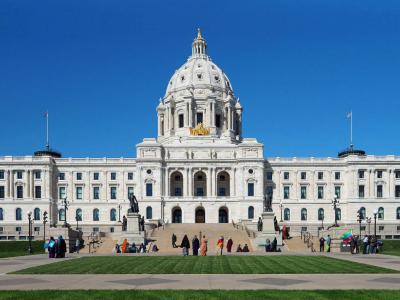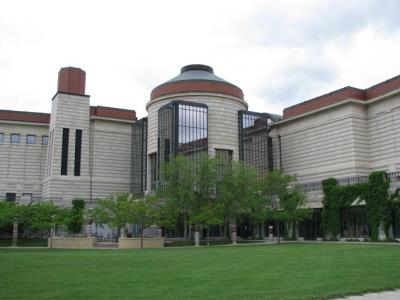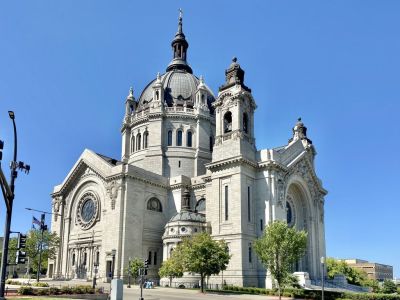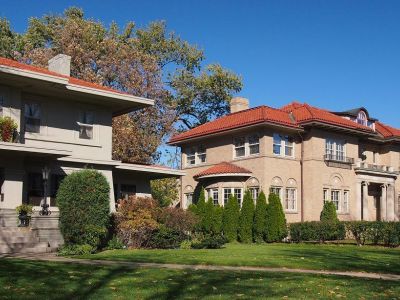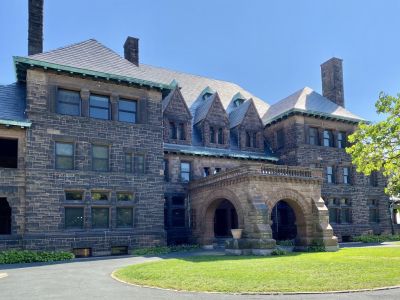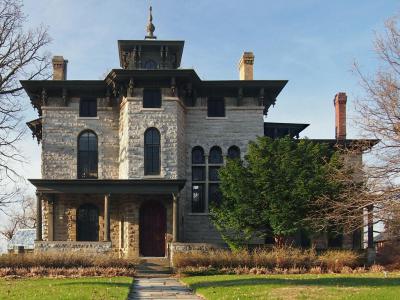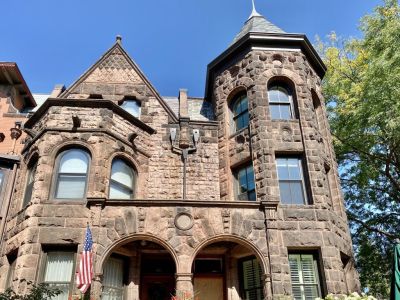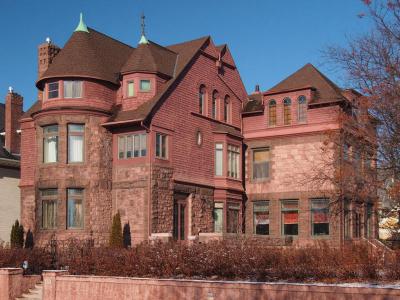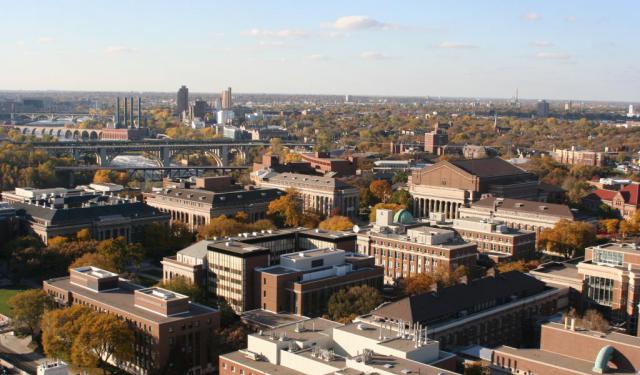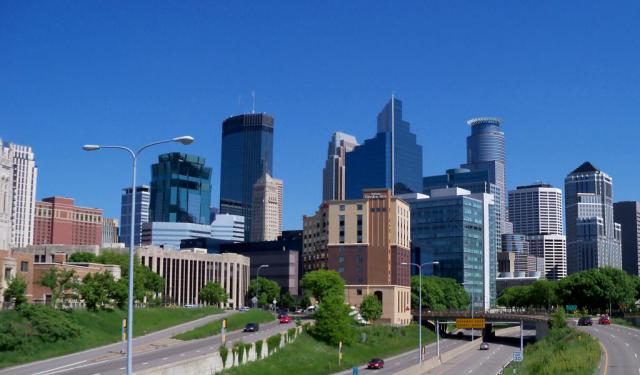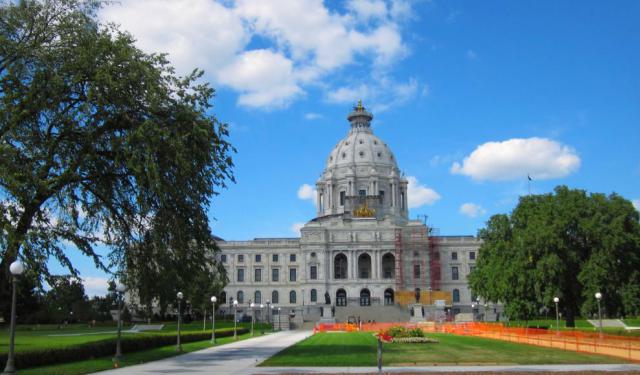
Saint Paul Introduction Walking Tour (Self Guided), Minneapolis
Saint Paul is a fantastic example of a city that has grown through a diverse range of cultures. The location near the Mississippi River helped make what would later become the city a significant center of local trade. The Dakota Sioux tribe were among the earliest residents, and European settlement that included French-Canadian fur traders and Catholic missionaries occurred during the 1830s to 1840s.
The Great Northern Railway helped pave the way for Saint Paul's growth into one of the Midwest's biggest cities. Much of the Downtown area saw significant growth during the 1970s and 1980s, with Galtier Plaza and Wells Fargo Place's construction. In recent decades, the city has diversified with immigrant groups that include Hmongs.
For a taste of history and modern life in Saint Paul, be sure to drop by The Minnesota State Capitol. If you're ready to get a more in-depth introduction to local history, try The Minnesota History Center. You can learn more about the religious and ethnic heritage of European ethnic groups at the Cathedral of Saint Paul.
If getting a look at historic homes is something that appeals to you, Summit Avenue should top your list. This street is home to The James J. Hill House, which is open for public tours and features a wealth of exhibits worth your time. The other homes on this street also serve as beautiful examples of Victorian architecture.
To learn more about Saint Paul and what the city offers, take this self-guided walking tour.
The Great Northern Railway helped pave the way for Saint Paul's growth into one of the Midwest's biggest cities. Much of the Downtown area saw significant growth during the 1970s and 1980s, with Galtier Plaza and Wells Fargo Place's construction. In recent decades, the city has diversified with immigrant groups that include Hmongs.
For a taste of history and modern life in Saint Paul, be sure to drop by The Minnesota State Capitol. If you're ready to get a more in-depth introduction to local history, try The Minnesota History Center. You can learn more about the religious and ethnic heritage of European ethnic groups at the Cathedral of Saint Paul.
If getting a look at historic homes is something that appeals to you, Summit Avenue should top your list. This street is home to The James J. Hill House, which is open for public tours and features a wealth of exhibits worth your time. The other homes on this street also serve as beautiful examples of Victorian architecture.
To learn more about Saint Paul and what the city offers, take this self-guided walking tour.
How it works: Download the app "GPSmyCity: Walks in 1K+ Cities" from Apple App Store or Google Play Store to your mobile phone or tablet. The app turns your mobile device into a personal tour guide and its built-in GPS navigation functions guide you from one tour stop to next. The app works offline, so no data plan is needed when traveling abroad.
Saint Paul Introduction Walking Tour Map
Guide Name: Saint Paul Introduction Walking Tour
Guide Location: USA » Minneapolis (See other walking tours in Minneapolis)
Guide Type: Self-guided Walking Tour (Sightseeing)
# of Attractions: 8
Tour Duration: 2 Hour(s)
Travel Distance: 3.4 Km or 2.1 Miles
Author: ChristineS
Sight(s) Featured in This Guide:
Guide Location: USA » Minneapolis (See other walking tours in Minneapolis)
Guide Type: Self-guided Walking Tour (Sightseeing)
# of Attractions: 8
Tour Duration: 2 Hour(s)
Travel Distance: 3.4 Km or 2.1 Miles
Author: ChristineS
Sight(s) Featured in This Guide:
- Minnesota State Capitol
- Minnesota History Center
- Cathedral of Saint Paul
- Summit Avenue
- James J. Hill House
- Burbank–Livingston–Griggs House
- F. Scott Fitzgerald House
- Frank B. Kellogg House
1) Minnesota State Capitol (must see)
The Minnesota State Capitol hosts the Senate and House of Representatives, the Attorney General's office, and the Governor's office. This building was completed in 1905, marking the third building to serve as the state's capital. The capital has enjoyed status on the National Historic Register since 1972.
One of the most impressive features is the marble dome, the second-largest self-supporting dome in the world. Both grand staircases, the 36 columns, and the rotunda, feature granite and marble from Minnesota and Georgia, as well as Italy. This rotunda features impressive murals dedicated to the area's settlement.
A highlight of this building is the Governors Reception Room, which has impressive decor, including woodwork made from white oak and gilded moldings. When you see the rotunda, you'll have the chance to enjoy the star set on the floor made from glass. There is also a wealth of art commemorating the Civil War that any history enthusiast will love.
One of the most impressive features is the marble dome, the second-largest self-supporting dome in the world. Both grand staircases, the 36 columns, and the rotunda, feature granite and marble from Minnesota and Georgia, as well as Italy. This rotunda features impressive murals dedicated to the area's settlement.
A highlight of this building is the Governors Reception Room, which has impressive decor, including woodwork made from white oak and gilded moldings. When you see the rotunda, you'll have the chance to enjoy the star set on the floor made from glass. There is also a wealth of art commemorating the Civil War that any history enthusiast will love.
2) Minnesota History Center
The Minnesota History Center is an ideal place to learn more about Minnesota's history across all eras. In addition to a wealth of exhibits, you can see live performances and enjoy presentations. Some of the most popular featured exhibits have included women's contributions to the state's history and Native American heritage.
There are also exhibitions celebrating the generation that lived through World War II, a weather-related exhibit, and hands-on experiences for kids. This museum also features a library with collections dating back to 1849. Programs are available that provide in-depth perspectives on many of the topics of the exhibits.
If you want to take something home after your visit, you won't want to pass up the museum's store. Some of the things that you might find include books about Minnesota history, jewelry and gifts, and locally-made goods. There are also toys if you'd like to pick something up for a special kid in your life.
There are also exhibitions celebrating the generation that lived through World War II, a weather-related exhibit, and hands-on experiences for kids. This museum also features a library with collections dating back to 1849. Programs are available that provide in-depth perspectives on many of the topics of the exhibits.
If you want to take something home after your visit, you won't want to pass up the museum's store. Some of the things that you might find include books about Minnesota history, jewelry and gifts, and locally-made goods. There are also toys if you'd like to pick something up for a special kid in your life.
3) Cathedral of Saint Paul (must see)
The seat of the Catholic diocese, Cathedral of Saint Paul in St. Paul is the national shrine dedicated to St. Jude that has a lot to offer regardless of your religious background. A copper dome adds to the cathedral's unique appearance, along with its distinction as America's sixth-largest church building and the third-largest church serving as a Catholic cathedral.
This building has been on the National Register of Historic Places since 1974 and is customarily open to visitors daily. Some of the important sculpture includes hand-carved angels in a human size, St. Cecelia who is the patron saint of music, and the four evangelists.
There is a rose window above the Aeolian-Skinner organ and 24 stained-glass windows featuring images of angelic choirs. This cathedral also features ten chapels. Six of these have been dedicated to the patron saints of the primary ethnic groups that settled the area, along with St. Peter, Mary, and Joseph, and the Sacred Heart.
This building has been on the National Register of Historic Places since 1974 and is customarily open to visitors daily. Some of the important sculpture includes hand-carved angels in a human size, St. Cecelia who is the patron saint of music, and the four evangelists.
There is a rose window above the Aeolian-Skinner organ and 24 stained-glass windows featuring images of angelic choirs. This cathedral also features ten chapels. Six of these have been dedicated to the patron saints of the primary ethnic groups that settled the area, along with St. Peter, Mary, and Joseph, and the Sacred Heart.
4) Summit Avenue (must see)
Summit Avenue is four and a half miles long and hosts 373 of the 440 homes representing the Victorian era. These houses were home to some of St. Paul's most prominent early families and represent a variety of architectural styles. Because of these homes' age, some of them even boast a reputation for being haunted that you're likely to find interesting.
The National Historic Landmarks on this street include the Frank B. Kellogg House, the F. Scott Fitzgerald House, and the James J. Hill House. National Register of Historic Places homes here include the Burbank–Livingston–Griggs House, the Pierce and Walter Butler House, and Dr. Ward Beebe House. Other important Historic Landmarks on this street include the Cathedral of Saint Paul and the Minnesota Governor's Residence.
The James J. Hill House is open for public tours on Wednesdays through Sundays. The homes that are viewable only from the outside offer plenty of excellent photo opportunities - take as much or as little time as you want, enjoying these historic beauties.
The National Historic Landmarks on this street include the Frank B. Kellogg House, the F. Scott Fitzgerald House, and the James J. Hill House. National Register of Historic Places homes here include the Burbank–Livingston–Griggs House, the Pierce and Walter Butler House, and Dr. Ward Beebe House. Other important Historic Landmarks on this street include the Cathedral of Saint Paul and the Minnesota Governor's Residence.
The James J. Hill House is open for public tours on Wednesdays through Sundays. The homes that are viewable only from the outside offer plenty of excellent photo opportunities - take as much or as little time as you want, enjoying these historic beauties.
5) James J. Hill House (must see)
The James J. Hill House stands as a shining example of architecture and furnishings going back to The Gilded Age. The 1891 mansion features construction using design elements inspired by Newport, Rhode Island mansions. This home spans five floors, with a total of 36,500 square feet of space.
Some of this home's key features include 16 chandeliers with cut glass, a two-story art gallery featuring a skylight, and a reception hall spanning 88 feet. The house also has a pipe organ three stories tall. The woodwork includes mahogany and oak with elaborate carvings that were hand-crafted.
The home features regular exhibits from local artists. Many of these exhibits highlight the plant and wildlife of Minnesota. Special events that visitors here might enjoy include concerts. You can even drop by the house's museum shop to buy books about the house's history, as well as souvenirs related to the home.
Some of this home's key features include 16 chandeliers with cut glass, a two-story art gallery featuring a skylight, and a reception hall spanning 88 feet. The house also has a pipe organ three stories tall. The woodwork includes mahogany and oak with elaborate carvings that were hand-crafted.
The home features regular exhibits from local artists. Many of these exhibits highlight the plant and wildlife of Minnesota. Special events that visitors here might enjoy include concerts. You can even drop by the house's museum shop to buy books about the house's history, as well as souvenirs related to the home.
6) Burbank–Livingston–Griggs House
The Burbank–Livingston–Griggs House is built from gray limestone and spans three stories. Built during the mid-19th century, the home features Italianate architecture. Over the years, the house has undergone renovations that resulted in three distinct units. With 8,000 square feet and a lot on 1.28 acres, the property is very impressive.
French and Italian boiseries dating back to the 18th century are present in eight rooms. The house also features a ballroom, as well as chandeliers, and a grand staircase. Marble and parquet floors are also present throughout the house, adding to the antique feel.
Because the house's three units are used as residences, visitors will see it from the outside. The building is open to the public only for special events. However, visitors will appreciate the chance to enjoy the outside of this house and take pictures featuring the exterior. The house is an impressive example of the type of architecture once prevalent in this city.
French and Italian boiseries dating back to the 18th century are present in eight rooms. The house also features a ballroom, as well as chandeliers, and a grand staircase. Marble and parquet floors are also present throughout the house, adding to the antique feel.
Because the house's three units are used as residences, visitors will see it from the outside. The building is open to the public only for special events. However, visitors will appreciate the chance to enjoy the outside of this house and take pictures featuring the exterior. The house is an impressive example of the type of architecture once prevalent in this city.
7) F. Scott Fitzgerald House
The F. Scott Fitzgerald House is the home where the author resided when he wrote "This Side of Paradise," the first novel that he published. This house was where Fitzgerald grew up and is a rowhouse featuring a style that was popular in the late 19th and early 20th centuries.
Besides being his residence when he wrote the novel, this house was also the author's birthplace. The house's National Historic Landmark status dates to 1971. When the city established its Historic Hill District in 1976, this property was one of the first houses listed.
The house is not open to the public due to its current use as a private residence. However, people can still fully appreciate the architecture from the street. There is a two-story bay window, as well as two arch-style windows at the roof level enhanced with decorative finials that show elements of period style.
Besides being his residence when he wrote the novel, this house was also the author's birthplace. The house's National Historic Landmark status dates to 1971. When the city established its Historic Hill District in 1976, this property was one of the first houses listed.
The house is not open to the public due to its current use as a private residence. However, people can still fully appreciate the architecture from the street. There is a two-story bay window, as well as two arch-style windows at the roof level enhanced with decorative finials that show elements of period style.
8) Frank B. Kellogg House
The Frank B. Kellogg House belonged to the Nobel Prize-winning author Frank B. Kellogg and has enjoyed status as a National Historic Landmark since 1976. Because of the house's age and place in the city's history, the home is also part of the Historic Hill District, placing it in the company of some of the city's most famous properties.
This house spans two and a half stories, and most of the construction is stone. Brownstone, granite, and sandstone are the most commonly used stone on the house's exterior. The three varieties of stone blend together nicely to create a stunning look.
Architecture enthusiasts will enjoy the house's original 1890 design. The styles used for the house's central part are a mixture of Queen Anne and Romanesque, two of the era's most popular styles. An addition to this house was built in 1923 and blends perfectly with the rest of the home.
This house spans two and a half stories, and most of the construction is stone. Brownstone, granite, and sandstone are the most commonly used stone on the house's exterior. The three varieties of stone blend together nicely to create a stunning look.
Architecture enthusiasts will enjoy the house's original 1890 design. The styles used for the house's central part are a mixture of Queen Anne and Romanesque, two of the era's most popular styles. An addition to this house was built in 1923 and blends perfectly with the rest of the home.
Walking Tours in Minneapolis, Minnesota
Create Your Own Walk in Minneapolis
Creating your own self-guided walk in Minneapolis is easy and fun. Choose the city attractions that you want to see and a walk route map will be created just for you. You can even set your hotel as the start point of the walk.
Historical Churches
The "City of Lakes”, Minneapolis, doesn't pride itself solely on the lakes. In fact, you will be amazed by how many churches, cathedrals, and other places of worship are found throughout the city. These sacred structures have played a significant role in the development of Minneapolis and continue to serve as pillars of faith and community. Let's take a look at some of the most... view more
Tour Duration: 1 Hour(s)
Travel Distance: 2.8 Km or 1.7 Miles
Tour Duration: 1 Hour(s)
Travel Distance: 2.8 Km or 1.7 Miles
University of Minnesota - Minneapolis Campus Walking Tour
Founded in 1851, seven years before Minnesota became a state, the University of Minnesota is one of the largest educational institutions in the United States. The university campus in the “Twin Cities” of Minneapolis and Saint Paul, spread along the bank of the Mississippi River, is a sprawling hub renowned for its rich academic environment and vibrant life.
One of the central gathering... view more
Tour Duration: 2 Hour(s)
Travel Distance: 2.9 Km or 1.8 Miles
One of the central gathering... view more
Tour Duration: 2 Hour(s)
Travel Distance: 2.9 Km or 1.8 Miles
Minneapolis Introduction Walking Tour
Minneapolis is a major city in Minnesota, straddling the Mississippi River. Together with neighboring Saint Paul, the state capital of Minnesota, it forms the metropolitan area collectively known as the "Twin Cities."
Before European settlement, the site of Minneapolis was inhabited by Dakota people. The settlement was founded along Saint Anthony Falls — the only natural waterfall... view more
Tour Duration: 2 Hour(s)
Travel Distance: 4.2 Km or 2.6 Miles
Before European settlement, the site of Minneapolis was inhabited by Dakota people. The settlement was founded along Saint Anthony Falls — the only natural waterfall... view more
Tour Duration: 2 Hour(s)
Travel Distance: 4.2 Km or 2.6 Miles
The Most Popular Cities
/ view all
